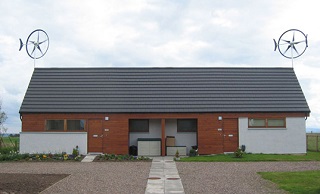From Guest Blogger Matt: Rooftop Wind Turbines

When it comes to natural, clean and renewable sources of energy, wind is one the best and cleanest resource you can find. It is one of many options when it comes to sustainability.
Large, industrial wind turbines have been in use for a while now. For example, there are wind farms that have tens or hundreds of turbines that can be as tall as a building. Together they generate huge amounts of energy. While the large turbines have been extremely energy efficient, small, residential rooftop wind turbines are still somewhat controversial and not as accepted. And not unreasonably so. While they are, to a degree, energy-efficient and green, using natural resources, i.e. energy created by the wind, there are still some downsides to it. Truth be told, they are still not as efficient as we would want them to be. But they are striving to be, and progress is being made towards perfecting them.
According to National Geographic, operational costs of having a rooftop wind turbine once it is installed, are almost non-existent since the wind is a free and natural source of renewable energy. In addition, and what is maybe not very widely known, many governments offer incentives, on both federal and local levels, to encourage the development of this renewable energy source. Technological progress and the increased production of wind turbines have also made them more affordable.
However, there are some things you should take into consideration before making any decisions about buying a wind turbine for your own roof:
- It is very important to consider the amount and the speed of wind in your area, or even more precisely, at the exact location of your house. It should be very windy in order for the turbines to work properly and sufficiently.
- Turbines work best at high altitudes, where the speed of wind increases, and houses are not really high enough. So there should at least be a clean and undisrupted air flow to the rooftop turbines, which means no obstacles such as trees, walls, other houses or buildings or anything that will disrupt the air flow.
- Turbines are also a bit noisy. It is not necessarily a problem, but should be considered, for example, it there are neighbors living close by that would mind and complain about it.
A small wind turbine could make economic sense, but if it does not, due to any of the said reasons, then a combination of solar panels and wind turbines is the way to go, if the goal is energy-efficient living. These two ways of using renewable energy sources complement each other very well. For example, in winter, when there is not as much sun, solar panels fall a bit short, and that is when the wind turbines take over and produce the needed extra energy. They also excel at night because the winds are stronger than during the day, and the solar panels cannot absorb the energy from the sun.
Steps are being made in the world of new technologies, and there has been progress. New small wind turbines are being created and improved in order to make them less noisy and, more importantly, to have them create more energy at smaller wind speeds.

Hi Matt and thank you for a well considered posting and your enthusiasm for generation technology is commendable and the world needs more Matt’s.
Wind energy is derived by converting naturally occurring (and freely available) potential energy caused by solar radiation interacting with the biosphere in both complex and sometimes quite simple to explain ways, but of course that is not what people are interested in as long as it works, which we all know it does.
But simply making something work is not the only issue to consider in the broader engineering/scientific context that applies to all things.
What actually drives the technology creative research and development chain as it strives for results is the quest for commercial reality where the technical outcomes are proven possible and also achievable (at an acceptable price point).
If commercial reality cannot be guaranteed through both objective and fearlessly independent analysis, project funding does ultimately evaporate and research moves on in another direction.
I would be interested to hear your thoughts on these points I have expressed Matt regarding wind power in general.
Lawrence Coomber
In the UK, residential wins turbines were promoted a few years ago with generally very poor results. Typically, wind speeds in urban areas – even where the wind speeds for the area are high are MUCH lower at rooftop height where surrounding buildings interfere than at 80 meters or so where larger commercial turbines generate their power.
With this situation applying, most such wind turbines achieved very low capacity factors at far higher cost than solar, and to make things even worse, the associated vibration and transmitted forces sometimes damaged the buildings they were on.
I would say therefore that this is a very niche application suitable for only judicious use in special situations.